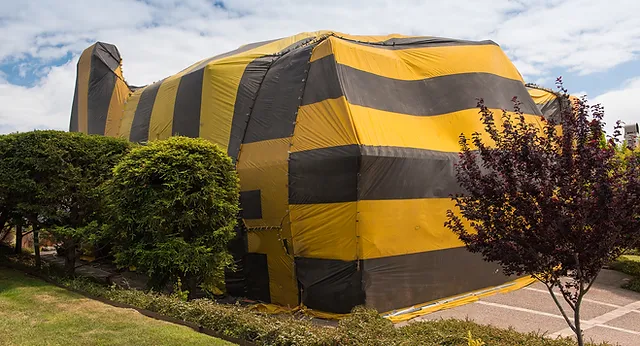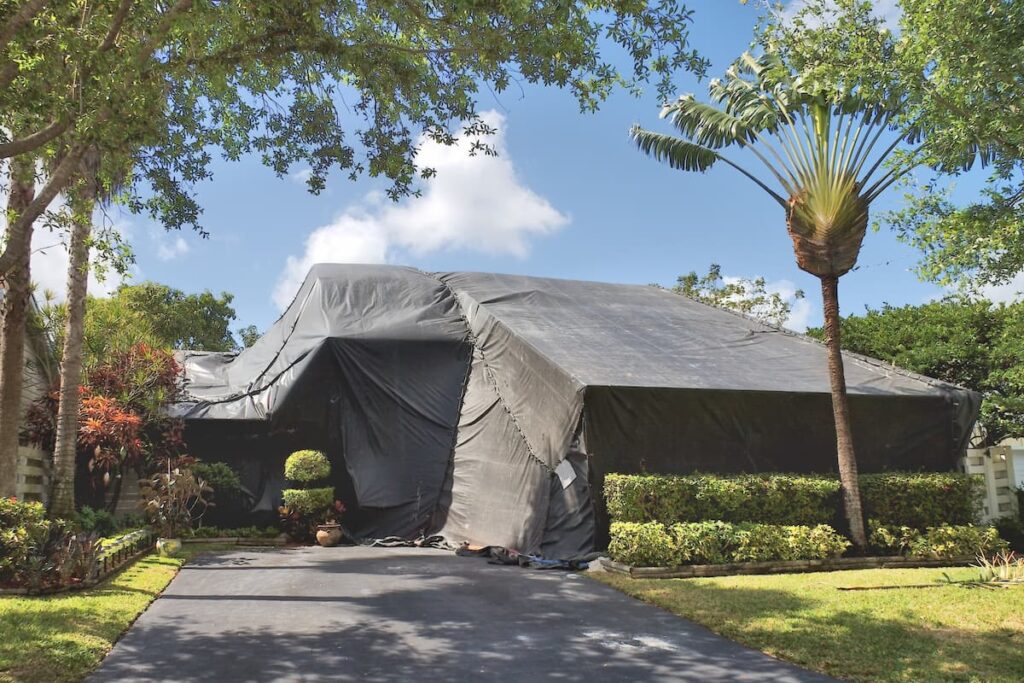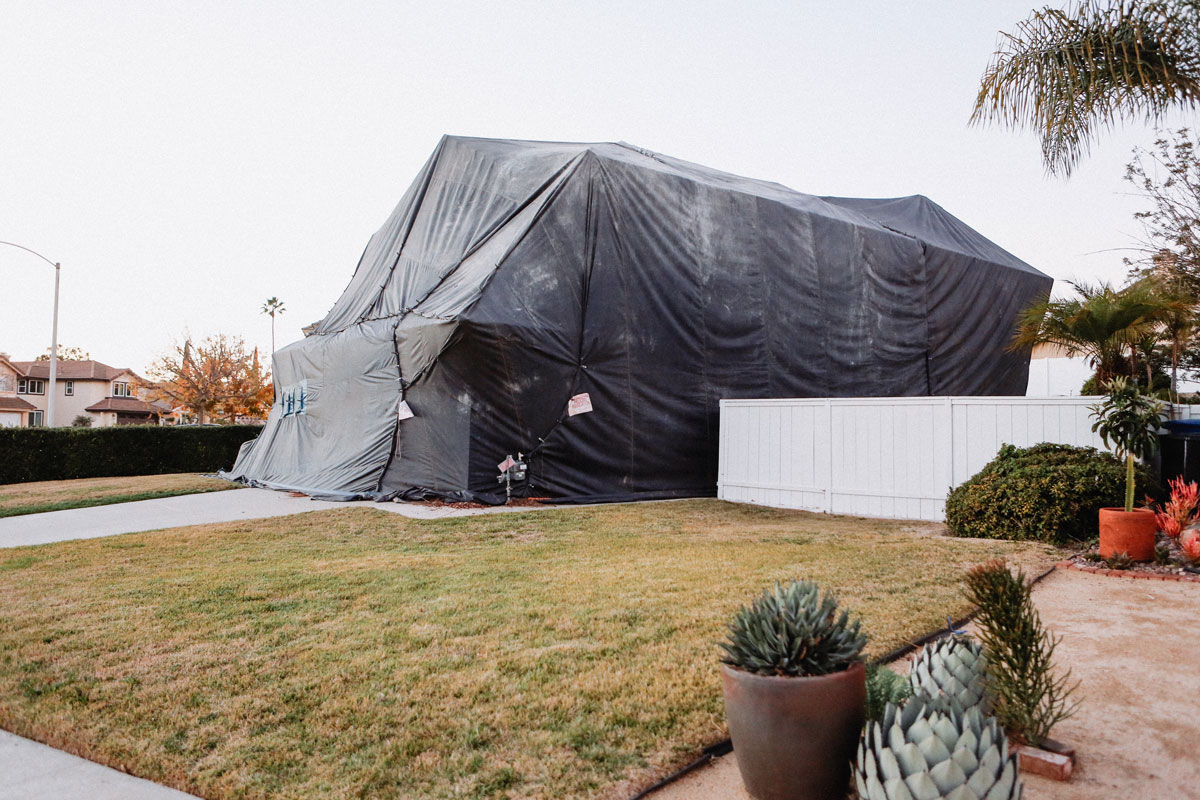In California, termite tenting is typically recommended every 5 to 10 years as a preventive measure, though the specific timing can vary based on factors like termite activity and previous treatments.
What are some signs that indicate the need for termite tenting?
Signs such as visible termite damage, swarming termites, or hollow-sounding wood can suggest a termite infestation. If you notice these signs, it’s essential to have an inspection done promptly to determine if tenting is necessary.
Besides, here are some signs that indicate that’s the time for termite tenting.
Frequency of Infestations:
- On average, California experiences about 2 to 3 termite infestations per year per square mile, making it a high-risk area.
- If you’ve had multiple termite infestations in the past, it may be wise to tent your property more frequently.
Type of Termites:
- California is home to both subterranean and drywood termites.
- Subterranean termites often require less frequent tenting (every 5-10 years) compared to drywood termites (every 2-5 years).
Local Climate and Geography:

- Coastal regions in California with higher humidity levels may necessitate more frequent tenting.
- Areas with a history of wildfires may require tenting to prevent termite infestations attracted to charred wood.
- In areas with a Mediterranean climate, like Southern California, where dry summers and mild winters prevail, tenting may be required every 5-7 years, while in more humid regions like the Central Valley or parts of Northern California, it could be needed every 3-5 years
Structural Vulnerability:
- Older wooden structures are more susceptible to termite infestations.
- Houses with untreated or damaged wood are at greater risk and may need tenting more often.
Infestation History:
If you’ve experienced multiple termite infestations in the past, it’s wise to tent more often to prevent recurring problems.
Visible Damage or Infestation Signs:
- If you notice damaged or hollowed wood, mud tubes, swarming termites, discarded wings, bubbling paint, noises in walls, or termite droppings, it’s essential to act promptly.
- Tenting may be necessary to eliminate an existing infestation and prevent further damage.
Professional Inspection:
- Regular inspections by licensed pest control professionals can provide precise recommendations for termite tenting.
- They might use special tools like moisture detectors and special cameras to find hidden termites.
The Balance Between Preventive Measures and Over-Tenting:
Preventive Approach:
- Tenting every 5-10 years as a precaution can prevent expensive repairs later on.
- Regular inspections by pest control professionals can help you identify the optimal timing for tenting.
Avoid Over-Tenting:
- Over-tenting can be costly and unnecessary if there are no signs of infestations.
- Rely on professional guidance and consider alternative termite control methods when appropriate.
So, determining how often to tent for termites in California requires considering various factors, including the type of termites, local climate, property history, and structural conditions.
Eco-Friendly Alternatives of Tenting Termites
A. Environmentally-Conscious Termite Control Options:
Localized Treatments:
- Consider localized treatments such as liquid termiticides or foam applications.
- These methods target specific termite infestation areas, reducing the need for whole-house tenting.
Bait Systems:
- Eco-friendly bait systems use low chemicals and focus on attracting termites to bait stations.
- They can be a more sustainable choice compared to tenting.
B. Comparing Tenting to Localized Treatments and Bait Systems:
Tenting (Fumigation):
Pros:
- Effective at eliminating extensive infestations.
- Provides whole-house protection.
Cons:
- Requires evacuation during the process.
- Involves the use of chemicals.
Localized Treatments:
Pros:
- Targets specific infestation areas.
- Reduced chemical use and minimal disruption.
Cons:
- It may not be suitable for widespread infestations.
- Multiple treatments may be necessary.
Bait Systems:
Pros:
- Minimal chemical use.
- Monitors termite activity over time.
Cons:
- It may take longer to show results.
- It is not ideal for immediate infestation control.
C. The Pros and Cons of Each Approach:
Tenting (Fumigation):
Pros:
- Rapid and thorough termite elimination.
- Provides whole-house protection.
Cons:
- Inconvenient due to evacuation.
- Chemical use and environmental impact.
Localized Treatments:
Pros:
- Reduced chemical use and environmental impact.
- Targeted approach for specific problem areas.
Cons:
- Limited effectiveness for extensive infestations.
- It may require multiple treatments.
Bait Systems:
Pros:
- Environmentally friendly with minimal chemical use.
- Continuous monitoring for long-term protection.
Cons:
- Slower results are not suitable for immediate infestations.
- Ongoing maintenance is needed.
Eventually, Determining how often to tent for termites in California involves considering eco-friendly alternatives like localized treatments and bait systems.
Each approach has its own set of pros and cons, making it essential to weigh the environmental impact, effectiveness, and convenience based on your specific termite situation.
The Termite Tenting Process
A. Overview of the Tenting Procedure:
Preparation:
- Prior to tenting, you’ll need to remove food, plants, and pets from your home.
- Professional pest control technicians will cover your property with a large tent made of specialized materials.
Fumigation:
- Once your home is tented, a lethal gas, usually sulfuryl fluoride (Vikane), is introduced.
- The gas penetrates the wood, targeting termites and other pests.
Aeration:
- After fumigation, the tent is removed, and your home is aerated to disperse any remaining gas safely.
Inspection:
- Pest control professionals will inspect your property to ensure effective termite elimination.
B. How Long Does Termite Tenting Typically Take?
Duration:
Termite tenting typically takes around 24 to 48 hours, depending on the size of your property and the severity of the infestation.
Return Home:
You can usually return to your home after it’s been deemed safe by pest control experts.
C. Safety Considerations for Your Family and Pets:
Evacuation:
- Make sure your family and pets leave your home during tenting
- . Follow the advice given by the pest control experts.
Food and Medications:
- Remove or double-bag all food and medications to prevent contamination.
- Consult with pest control experts for guidance on handling pet food and medications.
Ventilation:
- Ventilate your home thoroughly after termite tenting to ensure it’s safe for reentry.
Preparation and Post-Tenting Steps
Understanding the preparation and post-tenting steps is essential for California homeowners considering termite tenting. Before the process begins, clear your home and notify neighbors.
Here’s what you need to do when preparing for the tenting process.
A. What to Do Before the Tenting Process Begins:
Clear the Area:
- Remove plants, food, and pets from your home.
- Store food securely in airtight containers to prevent contamination.
Notify Neighbors:
- Inform your neighbors about the upcoming termite tenting to ensure their awareness.
Unplug Appliances:
- Disconnect electrical appliances, including the refrigerator, to protect them from potential damage during fumigation.
B. Actions to Take After Your Home Is Cleared for Reentry:
Aeration Period:
- Wait until the pest control professionals confirm that it’s safe to return.
- Follow their instructions regarding the duration of the aeration period.
Cleaning:
- Clean your home thoroughly to remove any residue from the tenting process.
- Wash dishes, utensils, and surfaces to ensure they are safe for use.
Inspect for Damage:
- Check your property for any potential damage caused during the tenting process.
- Report any concerns to the pest control company for evaluation.
C. Maintenance and Follow-Up Inspections:
Regular Inspections:
- Schedule regular termite inspections to catch infestations early.
- Consult with pest control experts for the recommended frequency based on your location.
Wood Maintenance:
- Repair or replace damaged wood to prevent future termite infestations.
- Consider using termite-resistant materials for construction and renovation.
Landscaping Considerations:
- Keep plants and trees away from your home’s foundation to minimize termite access.
Costs and Budgeting for termite tenting in California

A. Estimating the Cost of Termite Tenting in California:
Average Cost: In California, termite tenting costs can differ a lot, depending on your property’s size and how extensive the termite problem is.
Price Range: On average, termite tenting can range from $1,200 to $2,500 or more.
Factors Affecting Cost: Factors that influence cost include the type of termites, the size of your home, and the region within California.
Type of Termites:
- The species of termites infesting your property can significantly impact the cost of termite tenting. Different termite species may require varying treatment methods and levels of intervention.
- For instance, subterranean termites may be less costly to treat compared to dry wood termites, which tend to infest localized areas and may necessitate spot treatments instead of whole-house tenting.
Size of Your Home:
- The size of your home is a crucial determinant of termite tenting costs. Larger homes generally require more fumigant labor, leading to higher expenses.
- Pest control companies often calculate their fees based on square footage, so a larger living space typically results in a higher overall cost.
The region within California:
- The geographical location of your property within California can influence termite treatment costs. Different regions have varying termite activity levels and environmental conditions.
- Coastal regions with higher humidity levels, such as Southern California, may have more prevalent termite populations, potentially leading to higher treatment costs.
- Additionally, areas prone to wildfires may have unique termite challenges due to damaged wood, affecting the extent and type of treatment required.
B. Gathering Quotes from Pest Control Companies:
Get Multiple Quotes: To decide wisely, get quotes from multiple licensed pest control companies.
Ask Questions: During the quote process, ask questions about the treatment methods, chemicals used, and any guarantees or warranties offered.
Compare Services: Assess the services offered by each company, ensuring they align with your termite control needs.
C. Budgeting Tips and Considerations:
Plan Ahead: Include termite control in your long-term home maintenance budget. Regular inspections can help you catch infestations early, potentially reducing treatment costs.
Emergency Fund: Consider setting aside an emergency fund for unexpected home repairs, including termite-related expenses.
Insurance: Review your homeowner’s insurance policy to understand what termite-related damages are covered.
Payment Options: Some pest control companies offer financing options or payment plans, making it easier to manage the cost.
FAQs
How often should I tent for termites in California?
Tenting for termites is typically recommended every 5 to 10 years as a preventive measure, but the frequency may vary depending on the acuteness of termite activity in your area.
Can I tent for termites on my own?
No, termite tenting should not be done on your own; it requires professional expertise and specialized equipment for safety and effectiveness.
Are there eco-friendly alternatives to termite tenting in California?
Yes, some pest control companies offer eco-friendly alternatives to termite tenting in California, such as localized spot treatments or bait systems, which may be less intrusive than tenting.
How long does the termite tenting process typically take?
Termite tenting usually takes 2 to 3 days, including the time for preparation, fumigation, and aeration, to ensure your home is safe to re-enter.
Is termite tenting safe for my family and pets?
Yes, Termite tenting is generally safe for your family and pets when conducted by licensed professionals, with proper precautions taken during the process.
Do I need to remove all my belongings from the house before tenting?
Yes, you need to remove or properly seal and bag all food items and medicines, and some items like plants and pets may need to be temporarily relocated before termite tenting.
Will termite tenting guarantee the complete elimination of termites?
Termite tenting is highly effective at eradicating termites present in your home at the time of treatment. However, it won’t prevent future infestations, so regular inspections and preventive measures are crucial.
What should I do after the termite tenting process is complete?
After the tenting is done and your home is deemed safe, you can return and unpack your belongings. It’s advisable to schedule follow-up inspections to monitor for any signs of termite activity.
Conclusion
In conclusion, tenting for termites in California every 5 to 10 years is recommended. To protect your home, remember these key points: schedule regular termite inspections, act preventively, and hire professionals for termite tenting.
By taking proactive steps and staying vigilant, California homeowners can significantly reduce the risk of termite infestations and safeguard their properties from potential damage. Your home’s safety is worth the effort.

